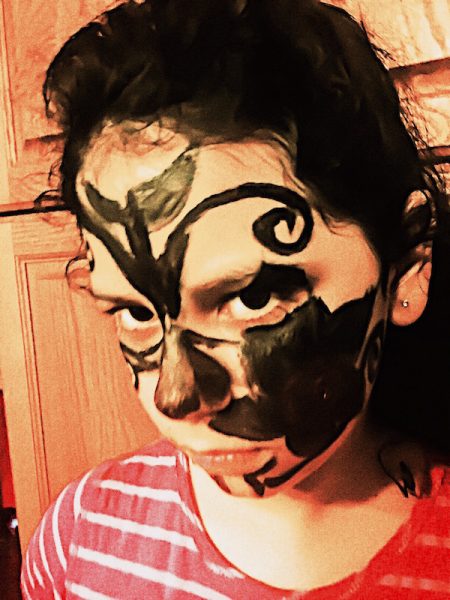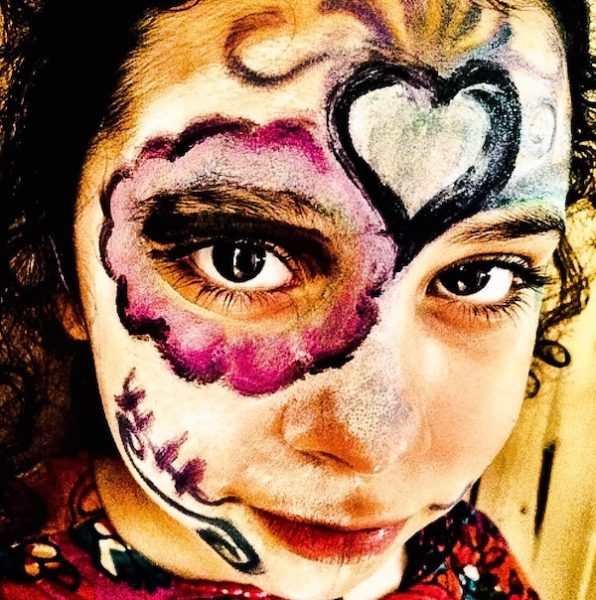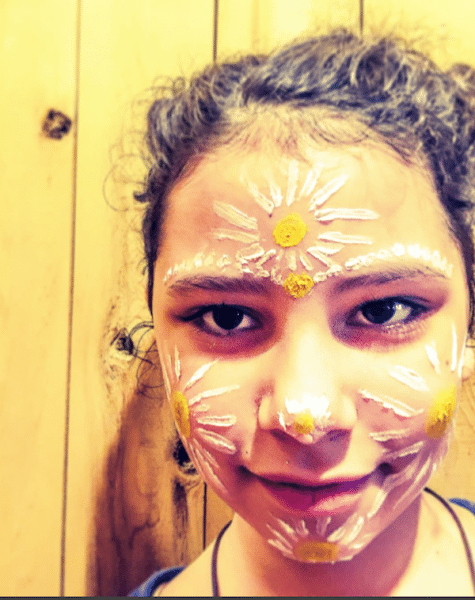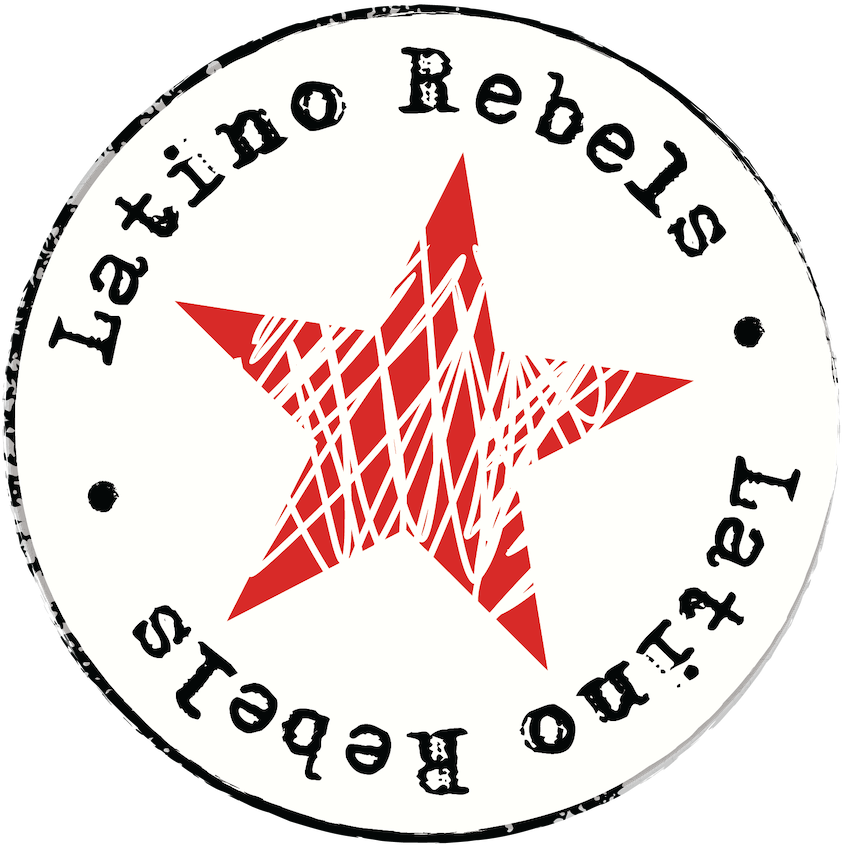I really wish other people would stop getting mad on my behalf.
Every year, it’s the same thing… and every year, I find myself sighing with the frustration of being told my opinion is wrong —or worse yet, makes me a “problematic minority”— for having the audacity to tell my white friends I believe painting their faces for Día de los Muertos is not cultural appropriation. If I thought it was, I’d have to rethink my daughter’s homeschool history and social studies lesson plans calling for activities like painting her face like a Maori warrior.


Our social studies lesson on the Maori warriors included face painting and discussion on the symbolism and importance of the practice to the culture. (Photo by Pamela Campos)
For the record, I’ve got a clear conscience on that front, too.
I’ve seen the same headlines I tend to see every year about this time in my social media timelines that culture is not a costume and how white people dressing as a Día de Los Muertos sugar skull is racist and offensive. I also see links for tips on celebrating the holiday crafts, and tutorials for face-painting posted by bloggers like my friend, Chicana author and artist Kathy Cano-Murillo, (a.k.a. Crafty Chica). I agree with the first point, mind you, but I don’t apply a blanket policy that automatically labels every white person with sugar skull makeup an appropriator of my culture. While white privilege does exist and cultural appropriation is a real problem, I do not think either concept applies to white people taking part in celebrating Día de Los Muertos, and certainly not to my daughter’s cultural lessons involving cultures outside our own.
Let me be clear: I am not offended if you are not of Latino/Latinx descent and you have embraced Día de Los Muertos in any way. My problem is being told I should be offended and having others getting mad on my behalf without asking my feelings first. Do not assume. I’m fine voicing my opinion when I’m actually offended by something.
Maybe it’s because I didn’t come to celebrate Dia de Los Muertos until adulthood, or maybe it’s because my circle of friends is so incredibly diverse. No matter the reason, I find myself speaking out on behalf of refocusing our collective efforts on cultural education. Intent speaks volumes. Respect for the traditions and costumes of another culture is something I will stand by and make room for. I won’t speak for other minority groups regarding sacred celebrations and traditions turned into a cheap, stereotypical costume, such as the Moana costume that Disney took heat for last year before pulling it from the market, but I think Día de Los Muertos is different.
At its core, the Day of the Dead celebrates life and our everlasting connection with our loved ones who’ve passed on. While steeped in indigenous beliefs and traditions, I don’t think it’s necessarily a bad thing for the world at large to let go of the fear so often associated with death.
By the time I first painted my daughter’s face for Día de Los Muertos, my father had already been dead seven years. He had died unexpectedly at the age of 50, and his death shook our family to the very core. As a first-generation Mexican-American, I was raised with the mindset of death being the end and wallowed in grief so deep I almost didn’t pull myself out. Sitting at my kitchen table two years ago, I painted my daughter’s face with the Día de Los Muertos face-painting kit that Kathy had gifted us from her own line of products. To ensure authenticity, I scoured the internet for examples of traditional Muerte sugar skull makeup, and my growing interest in a holiday my Mexican-born father and his family had never officially celebrated during my childhood morphed into a new way to cope with his death, inspiration for my art, and a natural extension of sharing both our culture and memories of my father with my daughter. Without intending it, that initial experience turned into one of our most meaningful educational moments when I learned the resulting photograph I’d taken of my daughter’s painted face had been selected for a juried art show.


My daughter, Eliana, when we first painted her face in an effort to learn about our heritage together. (Photo by Pauline Campos)
Here are the basics: Día de Los Muertos is celebrated throughout Latin America, but is most often associated with Mexico, and has been celebrated since long before Mexico actually existed. The holiday, which is officially celebrated on November 1 and 2, kicks off at midnight on the first night, which means that for those unfamiliar with Day of the Dead, it’s not uncommon for the holiday to be confused with the idea of a Mexican Halloween. (Pro tip: It’s not.) Altars, or ofrendas, are erected by the families of those departed, special foods and drinks like pan de muerto and atole are served, and faces are painted like calaveras de azúcar, or sugar skulls, in a beautiful cultural tradition meant to celebrate life and those who lived it. Death is not feared, but rather embraced as a part of the cycle of life.
Many of my non-Latino/Latinx friends privately share their stories of secret altars to their loved ones in their homes, fears of being accused of cultural appropriation when their only intentions were respect for the tradition and continued reverence and learning with me. Every year, I respond to each comment in my Facebook stream and private messages, thanking each person for sharing. I tell them how I can’t agree with a knee-jerk reaction to racist and offensive Halloween costume ideas that ignores genuine interest in and respect for a cultural tradition like Día de Los Muertos. Not when I see Latina/Latinx friends painting their own faces calavera-style for Halloween events and sharing links to face-painting tutorials for both calaveras and The Book of Life (and its memorable La Muerte character).
Disney trying to trademark Día de Los Muertos back in 2013? That, most definitely, qualified as cultural appropriation, and reeked of white privilege (Oh, Disney…) A white person finding joy and peace in the bright colors and comfort of a positive view of death, thanks to a holiday from another culture, does not.
As part of our social studies and ancient history curriculum, I have painted my daughter’s face like a Maori warrior after an ancient history lesson on New Zealand and Australia. I’ve also painted her face in the traditional style of the women of Madagascar for a Girl Scout event celebrating different countries (we turned it into an extra social studies lesson). We’ve cooked meals from other cultures and read stories from and about and even recreated ancient Chinese “artifacts” from air dry clay. Each activity was documented on my social media feeds and so far, I have only received support for my efforts to learn more about the people and the world around me with my daughter in her educational journey. I can only say that I hope that continues, because it seems we are forgetting that not everyone donning a cultural costume wishes disrespect. Many are trying to show it.


For World Thinking Day for the Girl Scouts a few years ago, Eliana taught other Brownie troops about Madagascar. We learned about traditional Malagasy face painting prior to the event. (Photo by Pauline Campos)
I don’t want cultural appropriation to cancel out the opportunity for cultural education. And that is what I fear will happen.
If the face behind the sugar skull makeup, white or otherwise, has taken the time to learn about the meaning of Día de Los Muertos, I think it’s okay. If the person taking the time to create an ofrenda to a departed loved one they miss in an effort to soothe their grief with a tradition that brings them joy band comfort, I’m not going to ask to see their Mexican card. Instead, I will light a candle with them and trade stories about our loved ones we never want to forget. And I will feel honor that it was a tradition from my culture that has brought them peace.
***
Find Pauline Campos at about.me/paulinecampos. Beware of rabbit holes.



Hey there! I’m a nearly 10 yr. homeschooler with a Cultural Anthro. background, and can appreciate the beauty and need for cultural education. Within the sphere of education, especially academics / homeschool, painting your face as an extension of a unit you’re covering isn’t all that bad, though you would need to ask yourself the reason behind it. Is it truly necessary to convey a point? If it’s an art project, could it have just as easily been applied to different medium vs a human face? Most often, it can be. Fear of cultural appropriation isn’t calling for the absence of cultural education/exposure, however there is a fine line between pure education/information and disrespect.
As for Día de Muertos, I won’t tell you whether you should/shouldn’t feel offended, but I can say that if you’re not, it’s likely because you aren’t Mexican, and though your dad was, as you mentioned, this celebration wasn’t a big part of your upbringing. For any Mexican it is a deeply spiritual, intimate, and personal gathering, as it was for me growing up. I have no problem with non Latinx celebrating or appreciating other cultures, by all means join in! But, it must be done with respect, and from a genuine intent to get closer to a culture or understand it better. And if that’s the objective and, you’re not Mexican or Hispanic, it makes sense to celebrate it *with* Hispanics, right? But I’ve seen it too often. Exclusively white people, girls in particular –for some reason–painting their faces as a trendy/fun/sexy thing to do, with zero knowledge of its significance, but calling it “cultural appreciation”. What’s worse, these same people want nothing to do with the culture or the people it belongs to all other days of the year.
So sure, go ahead and cerebrate, white people. But do so respectfully, around people who can provide more personal cultural insight, and at least, do a little reading past the obvious points. ✌?
Spot on, mate! I’m sick of people using my culture as something trendy or fashionable.
“Likely that you aren’t Mexican”?!? Wow? that is a serious leap, huh? Because of course the author’s genetic background inherently comes with some kind of cultural sameness as your experience. All Mexicans must feel the same as others or they probably aren’t really Mexican.
I find it quite incredible that neither the article nor the responses to it even mention the most popular animated cartoon to ever depict Mexican cultura and Dia de Los Muertos in a respectful way, namely COCO! To have ignored this media film phenomena and leave it out of the discussion in surprising and disappointing, moreover it makes Pauline´s commentary incomplete, especially regarding how the wider Anglo world views Mexicans and Mexican culture.
Hi, this essay was written and published a month before Coco came out. Check the date?
when other cultures worry about appropriating from others, than ill care
You really shouldn’t paint your child’s face as a “Māori warrior”. No-one in Aotearoa would ever do that. As a Social Studies teacher here, I just want you to know we would never, ever do that. Tā moko have very specific tikanga around them and each design reflects the specific person’s ancestry so they are very personal and not to be copied. Plus I’m wondering how they were included in an ‘ancient history’ lesson since a) the ancestors of Māori only arrived here around 1200AD, that’s not ancient history and b) tā moko and moko kauae are very much living, breathing customs. Studying whakairo patterns would be one thing, but painting tattoo patterns on a face is another entirely and won’t contribute to your daughter understanding Māori culture as it goes against Māori culture to do that. I appreciate your point of view on La Catrina and you have a point about the number of artists who are of Mexican descent who share tutorials on how to do this bit you will not find Māori artists sharing tutorials on how to ‘paint’ traditional tattoos that reflect individual ancestry for a good reason. It’s important not to extrapolate from one example to assume other examples are okay – perhaps best to ask first…